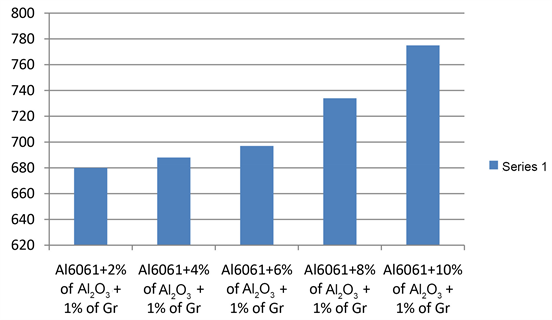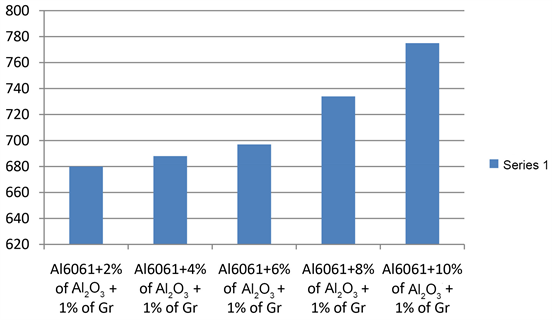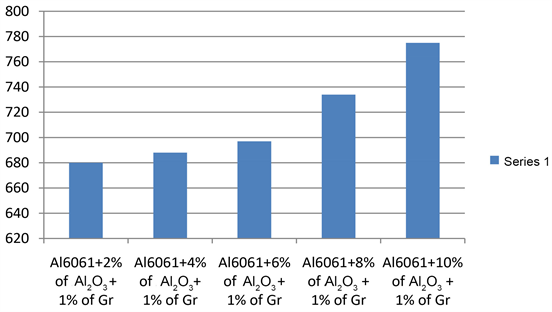Evaluation on Microstructure and Mechanical Behaviour of Al6061-Al2O3-Gr Hybrid Composites ()
1. Introduction
The hybrid composite materials are composed of two or more metal types in a matrix and they offer ancillary design freedom than non-hybrid composites. The main objective is to minimize the drawbacks of one of the metal types or material while keeping the benefits of the other. The composite materials play an important role in the field of science and engineering as well as modern manufacturing process technology in response to unprecedented demands from technology due to rapidly advancing activities in aircrafts, aerospace, sporting goods, marine and automotive industries [1]. In addition, the Metal Matrix Composites (MMCs) are being emerged as most advanced materials having the properties of lightweight, good wear resistance, low specific gravity that formulate their high specific strength and a low thermal expansion coefficient. Besides, the hybrid composites also demonstrate high electrical and thermal conductivity, high temperature stability; adjustable coefficients of thermal expansion, improved wear resistance etc. As a result of intensive studies into the fundamental nature of materials and better understanding of their structure-property relationship, it has become possible to develop new composite materials with improved physical and mechanical properties. These new materials include high performance composites such as reinforced composites. Continuous advancements have led to the use of composite materials in more and more diversified applications [2] [3] [4] [5] [6].
The investigators have described the term MMCs logically which is often equated with the term light MMCs. The substantial progress in the development of light metal matrix composites has been achieved in recent decades, so that they could be introduced into the most important real time applications [7]. In traffic engineering, especially in the automotive industry, MMCs have been used commercially in fiber reinforced pistons and Aluminum crankcases with strengthened cylinder surfaces as well as particle-strengthened brake disks [8]. The widely used reinforcing materials for these composites are silicon carbide; graphite is light weight and had high strength in the form of particles or whiskers. The ceramic particles reinforced aluminium composites are termed as new generation material and these can be tailored and engineered with specific required properties for specific application requirements. Particle reinforced composites have a better plastic forming capability than that of the whisker or fiber reinforced one, and thus they have emerged as most sought after material with cost advantage and they are also known for excellent heat and wear resistance application [9] [10] [11].
However, the hybrid composite materials have been subject of permanent interest of various specialists in the recent scenario by admitting military applications in the aircraft industry triggered off the commercial use of composites after the Second World War. The innovations in the composite area have allowed significant weight reduction in structural design. Composites offer many advantages when compared to metal alloys. There are several types of hybrid composites characterized as follows:
➢ Tow-by-Tow, in which tows of the two or more constituent types of fiber are mixed in a regular or random manner
➢ Sandwich hybrids, also known as core-shell, in which one material is sandwiched between two layers of another
➢ It can be subjected for lamination, where alternate layers of the two (or more) materials are stacked in a regular manner
➢ Intimately mixed hybrids, where the constituent fibers are made to mix as randomly as possible so that no over-concentration of any one type is present in the material
➢ Other kinds, such as those reinforced with ribs, pultruded wires, and thin veils of fiber or combinations of the above.
These innovative materials open up unlimited possibilities for modern material science and development; the characteristics of MMCs can be designed into the material, custom-made, dependent on the application. From this potential, MMCs fulfill all the desired conceptions of the designer [12]. This material group becomes interesting for use as constructional and functional materials, if the property profile of conventional materials either does not reach the increased standards of specific demands, or is the solution of the problem. However, the technology of MMCs is in competition with other modern material technologies, for example powder metallurgy. The advantages of the composite materials are only realized when there is a reasonable cost-performance relationship in the component production [13].
The need of best quality materials for industrial application demands to production of composite materials, Aluminium based particulate Metal Matrix Composites (MMCs) offer significant performance advantages over pure metals and metallic alloys and Aluminum alloy playing a vital role to get better results. Recently due to the necessity of engineering materials with high strength, increased wear resistance and enhanced temperature performance; hybrid aluminium metal matrix composites are developed [14]. Aluminum is the most accepted matrix for metal matrix composites because of its low density, ability to be strengthened by precipitation hardening, very good corrosion resistance, high thermal conductivity and electrical conductivity, and its high damping capacity. Al2O3 is one of the widely used second reinforcement. Al/Al alloy based metal matrix composites are widely used. Al alloy based MMC are being used as a material system in several applications such as Pushrods, cylinder, piston and brake disc etc. In last decade among all the aluminium alloys, Al6061 is (popular) admired as matrix material system in development of MMC’s owing to its good corrosion resistance and excellent mechanical properties [15].
In recent scenario, it was found that, among all the aluminium alloys, Al6061 is (popular) admired as matrix material system in development of MMC’s owing to its good corrosion resistance and excellent mechanical properties [16]. Al6061 alloy is heat treatable and as a result further increase in strength can be expected [3] [4] [5] , major focus is on processing and characterization of Al based MMC’s were reported [17] [18]. The type of reinforcement and synergic effect of heat treatment plays a prevailing (dominant) role command in the final mechanical properties of MMC’s meager information is available, pertaining to the heat treatment of Al based composites. In light of the above the present investigation is aimed at studying the effect of quenching media and ageing duration on the hardness property of Al6061 matrix alloy and Al6061-Frit particulate composites [19].
The mechanical properties of Al6061 alloy such as hardness and modulus can be significantly improved with SiC, graphite as reinforcement [20] [21]. However, micrometer-size SiC particles, graphite, tungsten reinforced Al6061 are usually faced with the problem of low ultimate tensile strength and ductility [22] due to particle fracture and particle/matrix interfacial failure. To overcome these limitations and to look for further improvement in mechanical properties, nanosize reinforcements are studied. Nanosize reinforcements are able to impart excellent properties to the Al6061 alloy matrix [23] at a much reduced amount of reinforcement material. Besides, the Mechanical properties of Al6061-Al2O3-Gr Hybrid composites have been studied and found that, the enhancement in mechanical properties. They have studied the properties up to 6% of Al2O3 without heat treatment. Subsequently, the mechanical properties of Al6061-Al2O3-Gr Hybrid composites & found the enhancement in mechanical properties [24] [25] [26] [27].
Hence, the advanced composite materials, such as graphite had lower density, higher strength, higher stiffness, less maintenance than the conventional aluminum alloys are being focused now. In order to minimize the inconsistency of composite materials, a hybrid composite material, supplemented with Silicon carbide and Graphite reinforced materials, was proposed in the study to evaluate the microstructure and mechanical properties for ascertaining its efficacy.
2. Materials and Methodology
The present Research project works carried-out at Dept. of Mechanical Engineering, Vivekananda Institute of Technology, Bangalore and Dept. of Applied Sciences & Mechanical Engineering, Maharaja Institute of Technology Thandavapura-571 302, Mysore district (Karnataka), India. In the study, the pre-requisite materials were identified and the composites were fabricated by liquid metallurgy route; vortex method [28] - [33]. The Casting set-up consisting of electrical resistance furnace with a mechanical stirrer unit was employed (Figures 1-3).
![]()
Figure 1. Electrical resistance furnace.
2.1. Materials Al6061-Al2O3
In the present study, the matrix materials were selected was Al6061 alloy and were procured from the authorized dealers, Bangalore, in the form of chunks. The reinforcing materials (2 - 10 weight percentage of Al2O3) and graphite (Gr-One weight percentage) of different particle size were prepared in order to discrete the same in the base Al6061alloy. The Casted hybrid composites were accomplished to introduce into machining process to prepare the specimens according to ASTM standards.
2.2. Casting of Al6061-Al2O3-Gr Hybrid Composites
The method adopted for preparation of composite was liquid metallurgy route. Al6061 is used as the base material and Al2O3 and Gr in powder form was chosen as the reinforcement materials. The matrix Al6061 was heated and melted in a resistance furnace with coil heating element. The maximum temperature limit is 1000˚C. Degassing is achieved by hexachloroethane tablet which were immersed into molten metal before stirring [1] [27] [28] [31].
In order to get uniform distribution of Al2O3 and Gr particles, the composites were stirred continuously for duration of 10 minutes. The composites melt was then poured into preheated metal mould. Al6061-Al2O3-Gr hybrid composites with 2 - 10 weight percentage of Al2O3 particulates and 1 weight percentage of Graphite have been successfully casted.
2.3. Specification of Furnace Used for Casting Process
➢ Type of furnace: Resistance furnace with coil heating element
➢ power capacity: 6 KW
➢ Melt capacity: 6 Kg
➢ Temperature: up to 1000˚C
➢ Heating element and Insulation: Kanthel Aluminal and Graded X\Ceramic
➢ Type of control: Digital control
➢ Stirring speed: 250 - 350 rpm
➢ Position of stirrer: 1 inch height from bottom of crucible and centrally located
➢ Mould temperature: 300˚C
The casting showed the microstructure of Al6061-Al2O3-Gr hybrid composites for further analysis. It shows a good chemical bonding among the Al particles, where Al particles joined together to construct a solid structure.
3. Results and Discussion
3.1. Microstructure
The microphotographs clearly indicate the evidence of minimal porosity in the prepared hybrid composites and the optical microphotographs of the Al6061-Graphite-Al2O3 hybrid composites are accomplished. It is observed that, the reinforcement materials have distributed homogeneously. However, at all load conditions are considered, the parameters on Microstructure analyzed of the hybrid composites (Figures 4-8) were superior to the matrix alloy and good agreement with the findings coupled with variable compositions [3] [7] [18] [21] [25].
3.2. Hardness
Hardness is a measure of the resistance of a material to plastic or permanent deformation. In the present study, hardness of the specimens was measured by
![]()
Figure 4. Al6061 + 2% of Al2O3 + 1% of Gr. Observation: Optical Microstructure consists of clusters of reinforcement particles (Al2O3 & Gr) in a matrix of aluminium solid solution.
![]()
Figure 5. Al6061 + 4% of Al2O3 + 1% of Gr. Observation: Optical Microstructure consists of clusters of reinforcement particles (Al2O3 & Gr) in a matrix of aluminium solid solution.
![]()
Figure 6. Al6061 + 6% of Al2O3 + 1% of Gr. Observation: Optical Microstructure consists of clusters of reinforcement particles (Al2O3 & Gr) in a matrix of aluminium solid solution.
![]()
Figure 7. Al6061 + 8% of Al2O3 + 1% of Gr. Observation: Optical Microstructure consists of clusters of reinforcement particles (Al2o3 & Gr) in a matrix of aluminium solid solution.
![]()
Figure 8. Al6061 + 10% of Al2O3 + 1% of Gr. Observation: Optical Microstructure consists of clusters of reinforcement particles (Al2O3 & Gr) in a matrix of aluminium solid solution.
using a standard Brinell hardness testing machine. It is observed from Table 1 that increased content of reinforcement in the matrix alloy results in enhanced hardness of the hybrid composite for the hybrid composite studied. The increase in the hardness is due to the addition of graphite at variable amounts, which can be attributed to the fact that the graphite possess higher hardness and its presence in the matrix improves the hardness of the composite.
The enhanced hardness of hybrid composites can also be attributed to the fact that the lesser extent of porosity is observed as evident in optical microphotographs. It is reported that higher hardness is associated with lower porosity of the MMCs [32] [33].
The result shows the variation of hardness with increased content of reinforcement for the hybrid composites. From the chart it can be concluded that
![]()
Table 1. Showing increased content of reinforcement in the matrix alloy.
the Hardness of Al6061-Al2O3-Gr hybrid composites increases when Al2O3 & Gr is added to Al6061 with different weight proportions. The Hardness for different Proportions of Al2O3 & Gr is shown in Table 1 & Graph 1.
3.3. Tensile Strength Test
Tensile test specimens were made as per the ASTM standard and tested in a Universal Testing Machine with standard configuration. As per the requirements of tensile testing standards of ASTM, the samples were machined into a cylindrical shape, before measuring the tensile strength. The tests were carried out at room temperature. Three samples were tested for each category to obtain the tensile test result; each result is an average of four readings.
The data was represented in Table 2 and Graph 2 which shows the Comparative study of cast hybrid composites with increased percentage of reinforcement. The result was significantly superior compared with earlier findings [34] [35].
Further, it can be accomplished that, the Tensile strength of Al6061-Al2O3-Gr hybrid-composites have been enhanced when Al2O3 & Gr is added to Al6061 with different weight proportions. The Tensile strength for different proportions of Al2O3 & Gr is shown in Table 2 & Graph 2.
3.4. Compressive Strength Test
The compressive strength of an MMC was found to be is invariably higher than its ultimate tensile strength. Hence, such MMCs are quite brittle compared with monolithic materials and have values of percentage elongation typically less than 5 per cent. The data on Compressive Strength showed the Comparative analysis of the cast hybrid composites with increased percentage of reinforcement. This is in accordance with the previous results and the outcome is extremely enhanced [3] [15] [22] [24] [36].
The Compressive strength of Al6061-Al2O3-Gr Hybrid composites have been enhanced when Al2O3 & Gr is added to Al6061 with different weight proportions. The Compressive strength for different Proportions of Al2O3 & Gr is represented in Table 3 & Graph 3 respectively.
On the whole, the results of the present studies revealed that with increasing the reinforcement content, all the parameters such as hardness, compressive

Graph 1. Showing variation of hardness with increased content of reinforcement for the hybrid composites.

Graph 2. Showing the tensile strength of Al6061-Al2O3-Gr hybrid-composites with enhancement when Al2O3 & Gr is added to Al6061 with different weight proportions.
strength followed by ultimate tensile strength were enhanced with respect to the industrial relevance. Besides, the hardness factor was realistic which admits the reinforcement content and found to be extremely significant [37] [38] [39] [40].
4. Conclusions
The study comprised of evaluating the various properties of Al6061-Al2O3-Gr MMC showed very promising approach towards industrial development. It is seen that micro-structural studies clearly reveal a uniform distribution of metal matrix alloy with an excellent bond between the matrix alloy and reinforcement. Micro-hardness of composites is found to be significant. Heat treatment has a significant effect on micro-hardness of Al2O3-Gr matrix alloy and its composites.
![]()
Table 2. Showing increased content of reinforcement in the matrix alloy.
![]()
Table 3. Showing comparative study of cast hybrid composites with increased percentage of reinforcement.

Graph 3. Showing compressive strength of Al6061-Al2O3-Gr hybrid composites with enhancement when Al2O3 & Gr is added to Al6061 with different weight proportions.
Heat treatment has a significant effect on this metal matrix alloy and its composites. Heat treatment has a profound effect on wear behavior of matrix alloy and its composites. In conclusion, the following aspects were drawn for attention to accomplish the subsequent objectives.
1) Al6061-Graphite-Al2O3 hybrid composites have been successfully prepared by Liquid metallurgy route. In this hybrid composite each percentage of graphite and Al2O3 has been successfully dispersed in the matrix alloy.
2) Microstructure studies reveal fairly uniform distribution of Graphite and Al2O3 particles in the matrix alloy with a good bonding between the matrix alloy and the reinforcement.
3) Hardness of the hybrid composites increases with increased content of Al2O3 with constant Graphite.
4) Tensile Strength of the hybrid composites increases with increased content of Al2O3 with constant Graphite.
5) Compressive Strength of the hybrid composites increases with increased content of Al2O3 with constant Graphite.
Possibility for Future Work
1) To assess tribological behavior of developed hybrid composites.
2) To undertake studies on corrosion behavior on the developed composites.
3) To explore the possibility of use of the developed hybrid composites in automobile and space sectors.
4) To evaluate the thermal characteristic of the developed hybrid composites.
Acknowledgements
The first Author expresses sincere gratitude to the Supervisors their valuable guidance, constant support and encouragement throughout the works. Also thankful to the authorities of the collaborative Organizations for providing crucial facilities to carry out this research work successfully.